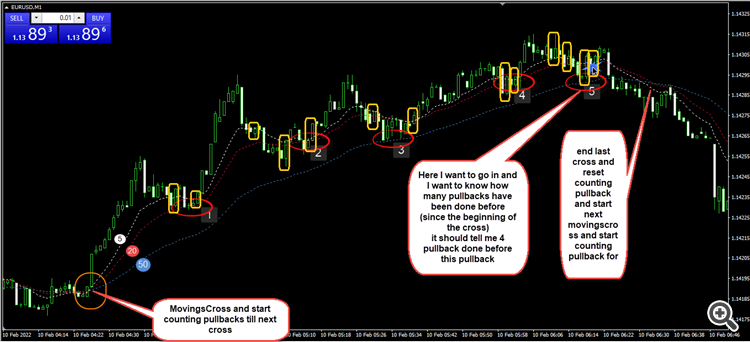But it is important for me to know How many pullbacks are we in right now?(After the last MovingsCross ). So my question is: How can I count the number of previous pullbacks after the last MovingsCross ?
Your first thing to do, is to ask yourself the question ... How do I define a pull-back?
You have to define it in a very detailed and objective way, so that it can be implemented in code. There must be no subjective or incongruent rules to the definition.
Only then can you, start to count them. It is no use asking for code for something so vague as the word "pullback". We humans know what it is but if not properly defined, how are you going to tell a machine to recognise one and then count them.
Your first thing to do, is to ask yourself the question ... How do I define a pull-back?
You have to define it in a very detailed and objective way, so that it can be implemented in code. There must be no subjective or incongruent rules to the definition.
Only then can you, start to count them. It is no use asking for code for something so vague as the word "pullback". We humans know what it is but if not properly defined, how are you going to tell a machine to recognise one and then count them.
It can be said that I agree with you But I believe that nothing is impossible
For almost a week now, I have been thinking about how to count the number of pullbacks after the MovingCross, but I have not gotten anything.
So here I am asking for help (requesting the code) to see if anyone can solve this problem...
I hope someone can write this code and solve my problem...
Answer the question; how do you define “pullback”. Until you define it in concrete terms, nobody can code it.
here your answer dear:
You show charts and graphics, but you still have not presented a clear, point-by-point recipe for a "pull-back". The code cannot just look at a graph or chart a "just know" what is a pullback.
You have to define it in very clear simple logical and mathematical rules, so that it can be coded. Sit down, take a pencil and paper and write it down. Break it down into steps, and keep breaking down those steps even further until you have a clear, unambiguous logical and mathematical recipe for recognising a pullback.
PS! Yes, I know it is not easy and that is why coders get so irritated when customers just want something done quick and cheap, yet have no idea how difficult and time consuming it is "convert" human terms into something a machine can identify and do. So, take this time to place yourself in the coder's mindset and break it down into steps that can be coded.
You show charts and graphics, but you still have not presented a clear, point-by-point recipe for a "pull-back". The code cannot just look at a graph or chart a "just know" what is a pullback.
You have to define it in very clear simple logical and mathematical rules, so that it can be coded. Sit down, take a pencil and paper and write it down. Break it down into steps, and keep breaking down those steps even further until you have a clear, unambiguous logical and mathematical recipe for recognising a pullback.
PS! Yes, I know it is not easy and that is why coders get so irritated when customers just want something done quick and cheap, yet have no idea how difficult and time consuming it is "convert" human terms into something a machine can identify and do. So, take this time to place yourself in the coder's mindset and break it down into steps that can be coded.
Unfortunately your definition of a pull-back described above does not correspond with your chart. On your chart you count 5 pull backs, but according to your definition that would make it at least 12 pull-backs (possibly more) where a candle closing above the MA(5) and the previous closing below it. In other words, your definition is incomplete.
Unfortunately your definition of a pull-back described above does not correspond with your chart. On your chart you count 5 pull backs, but according to your definition that would make it at least 12 pull-backs (possibly more) where a candle closing above the MA(5) and the previous closing below it. In other words, your definition is incomplete.
Yes, you are right, let me correct the conditions a bit:
3- Then we enter the long Trade in candle[0]
is that ok now?
dude i just need to know how should i count the pullback before the current pullback
So do not be too sensitive to the conditions..
thanks
- Free trading apps
- Over 8,000 signals for copying
- Economic news for exploring financial markets
You agree to website policy and terms of use

hi everyone
I use two moving average 20 and 50 and I enter to the trade in the pullbacks. In fact, I enter trading after pullbacks when the price is above 20 (bullish trend) or below 20(bearish trend).
But it is important for me to know How many pullbacks are we in right now?(After the last MovingsCross )
So my question is:
How can I count the number of previous pullbacks after the last MovingsCross ?
(Please give me the mql4 code, i know i should use iLow and ILowest or somethings like that but i need the full code please so please help me with writing this indicator)
like this :
thank u so much guys